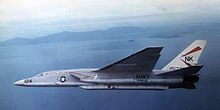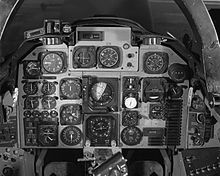- North American A-5 Vigilante
-
A-5 (A3J) Vigilante Role Nuclear strike bomber, reconnaissance aircraft Manufacturer North American Aviation First flight 31 August 1958 Introduction June 1961 Retired January 1980 Primary user United States Navy Produced 1956-1963
1968-1970Number built 156 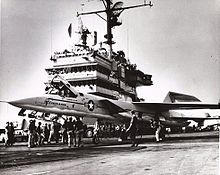 An A3J-1 during trials on USS Saratoga, 1960.
An A3J-1 during trials on USS Saratoga, 1960.
The North American A-5 Vigilante was a carrier-based supersonic bomber designed for the United States Navy. Its service in the nuclear strike role to replace the A-3 Skywarrior was very short; however, as the RA-5C, it saw extensive service during the Vietnam War in the tactical strike reconnaissance role. Prior to the unification of the Navy designation sequence with the Air Force sequence in 1962, it was designated the A3J Vigilante.[1]
Contents
Design and development
In 1953, North American Aviation began a private study for a carrier-based, long-range, all-weather strike bomber, capable of delivering nuclear weapons at supersonic speeds.[2] This proposal, the NAGPAW (North American General Purpose Attack Weapon) concept, was accepted by the United States Navy, with some revisions, in 1955.[3] A contract was awarded on 29 August 1956. Its first flight occurred two years later on 31 August 1958 in Columbus, Ohio.[4]
At the time of its introduction, the Vigilante was one of the largest and by far the most complex aircraft to operate from a United States Navy aircraft carrier. It had a high-mounted swept wing with a boundary-layer control system (blown flaps) to improve low-speed lift.[4] There were no ailerons. Roll control was provided by spoilers in conjunction with differential deflection of the all-moving tail surfaces. Use of aluminum-lithium alloy for wing skins and titanium for critical structures were also unusual. The A-5 had two widely-spaced General Electric J79 turbojet engines (the same as used on the McDonnell Douglas F-4 Phantom II fighter), and a single large all-moving vertical stabilizer.[2] Preliminary design studies had employed twin vertical fin/rudders.[4] The wings, vertical stabilizer and the nose radome folded for carrier stowage. The Vigilante had a crew of two seated in tandem, a pilot and a bombardier-navigator (BN)—reconnaissance/attack navigator (RAN) on later recon versions— in individual ejection seats.[1]
Despite being designated by the US Navy as a "heavy", the A-5 was surprisingly agile for such a large aircraft, without the drag of bombs or missiles, even escorting fighters found that the clean airframe and powerful engines made the Vigilante very fast at high and low altitudes. However, its high approach speed and high angle of attack in the landing configuration made returning to the aircraft carrier a challenge for inexperienced or unwary pilots.[5]
The Vigilante had advanced and complex electronics when it first entered service. It had one of the first fly-by-wire systems of an operational aircraft (with mechanical/hydraulic backup) and a computerized AN/ASB-12 nav/attack system incorporating a head-up display (Pilot's Projected Display Indicator (PPDI), one of the first), multi-mode radar, Radar-Equipped Inertial Navigation System (REINS, based on technologies developed for the Navaho missile), closed-circuit television camera under the nose, and an early digital computer known as VERDAN (Versatile Digital Analyzer) to run it all.
Given its original design as a carrier-based, supersonic, nuclear heavy attack aircraft, the Vigilante's main armament was carried in a novel "linear bomb bay" between the engines in the rear fuselage, which provided for positive separation of the bomb from the aircraft at supersonic speeds. The single nuclear weapon, commonly the Mk 28 bomb, was attached to two disposable fuel tanks in the cylindrical bay in an assembly known as the "stores train". A set of extendable fins was attached to the aft end of the most rearward fuel tank. These fuel tanks were to be emptied during flight to the target and then jettisoned with the bomb by an explosive drogue gun. The stores train was propelled rearward at about 50 feet per second (30 knots) relative to the aircraft, not at the aircraft's forward speed as stated in some references. It therefore followed a typical ballistic arc rather than "falling straight down." [6]
In practice the system was not reliable and no live weapons were ever carried in the linear bomb bay. In the RA-5C configuration, the bay was used solely for fuel. On three occasions the shock of the catapult launch caused the fuel cans to eject onto the deck resulting in one aircraft loss.[7]
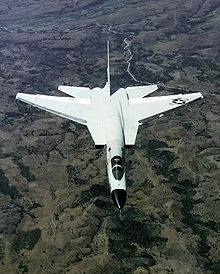 An planform aerial view of an RA-5C Vigilante aircraft.
An planform aerial view of an RA-5C Vigilante aircraft.
The Vigilante originally had two wing pylons, intended primarily for drop tanks. The second Vigilante variant, the A3J-2 (A-5B), incorporated internal tanks for an additional 460 gallons of fuel (which added a pronounced dorsal "hump") along with two additional wing hardpoints, for a total of four. In practice the hardpoints were rarely used. Other improvements included blown flaps on the leading edge of the wing and sturdier landing gear.
The reconnaissance version of the Vigilante, the RA-5C, had slightly greater wing area and added a long canoe-shaped fairing under the fuselage for a multi-sensor reconnaissance pack. This added an APD-7 side-looking airborne radar (SLAR), AAS-21 infrared linescanner, and camera packs, as well as improved ECM. An AN/ALQ-61 electronic intelligence system could also be carried. The RA-5C retained the AN/ASB-12 bombing system, and could, in theory, carry weapons, although it never did in service. Later-build RA-5Cs had more powerful J79-10 engines with afterburning thrust of 17,900 lbf (80 kN). The reconnaissance Vigilante weighed almost five tons more than the strike version with almost the same thrust and an only modestly enlarged wing. These changes cost it acceleration and climb rate, though it remained fast in level flight.
Operational history
Designated A3J-1, the Vigilante first entered squadron service with Heavy Attack Squadron THREE (VAH-3) in June 1961 at Naval Air Station Sanford, Florida, replacing the A-3 Skywarrior in the heavy attack role.[8] All variants of the Vigilante were built at North American Aviation's facility at Port Columbus Airport in Columbus, Ohio, alongside the T-2 Buckeye and OV-10 Bronco.
Under the Tri-Services Designation plan implemented under Robert McNamara in September 1962, the Vigilante was redesignated A-5, with the initial A3J-1 becoming A-5A and the updated A3J-2 becoming A-5B. The subsequent reconnaissance version, originally A3J-3P, became the RA-5C.
The Vigilante's early service proved troublesome, with many teething problems for its advanced systems. Although these systems were highly sophisticated, the technology of the time was in its infancy, and its reliability was poor. In early squadron service, the MTBF (Mean Time Between Failures) for some systems was sometimes as short as 15 minutes.[citation needed] Although most of these reliability issues were eventually worked out as maintenance personnel gained greater experience with supporting these systems, the aircraft tended to remain a maintenance-intensive platform throughout its career.
The A-5's service coincided with a major policy shift in the U.S. Navy's strategic role, which switched to emphasize submarine launched ballistic missiles rather than manned bombers. As a result, in 1963, procurement of the A-5 was ended and the type was converted to the fast reconnaissance role. The first RA-5C's were delivered to the Replacement Air Group (RAG)/Fleet Replacement Squadron (FRS), redesignated as Reconnaissance Attack Squadron THREE (RVAH-3) at NAS Sanford, Florida in July 1963, with all Vigilante squadrons subsequently redesignated RVAH. Under the cognizance of Reconnaissance Attack Wing ONE, a total of 10 RA-5C squadrons were ultimately commissioned. RVAH-3 continued to be responsible for the stateside-based RA-5C training mission of both flight crews, maintenance and support personnel, while RVAH-1, RVAH-5, RVAH-6, RVAH-7, RVAH-9, RVAH-11, RVAH-12, RVAH-13 and RVAH-14 routinely deployed aboard Forrestal, Saratoga, Ranger, Independence, Kitty Hawk, Constellation, Enterprise, America, John F. Kennedy and eventually Nimitz-class aircraft carriers to the Atlantic, Mediterranean and Western Pacific.
Eight of 10 squadrons of RA-5C Vigilantes also saw extensive service in Vietnam starting in August 1964, carrying out hazardous medium-level reconnaissance missions. Although it proved fast and agile, 18 RA-5Cs were lost in combat: 14 to anti-aircraft fire, three to surface-to-air missiles, and one to a MiG-21 during Operation Linebacker II. Nine more were lost in operational accidents while serving with Task Force 77. Due, in part, to these combat losses, 36 additional RA-5C aircraft were built from 1968–1970 as attrition replacements.[9]
In 1968, Congress closed the aircraft's original operating base of NAS Sanford, Florida and transferred the parent wing, Reconnaissance Attack Wing ONE, all subordinate squadrons and all aircraft and personnel to Turner AFB, a Strategic Air Command (SAC) B-52 and Boeing KC-135 base in Albany, Georgia. The tenant SAC bomb wing was then deactivated and control of Turner AFB was transferred from the Air Force to the Navy with the installation renamed NAS Albany. In 1974, after barely six years of service as a naval air station, Congress opted to close NAS Albany as part of a post-Vietnam force reduction, transferring all RA-5C units and personnel to NAS Key West, Florida.
Despite the Vigilante's useful service, it was expensive and complex to operate and occupied significant amounts of precious flight deck and hangar deck space aboard both conventional and nuclear-powered aircraft carriers. With the end of the Vietnam War, disestablishment of RVAH squadrons began in 1974, with the last Vigilante squadron, RVAH-7, completing its final deployment to the Western Pacific aboard USS Ranger (CV-61) in late 1979. The final flight by an RA-5C took place on 20 November 1979 when a Vigilante departed NAS Key West, Florida.[10] Reconnaissance Attack Wing ONE was subsequently disestablished at NAS Key West, Florida in January 1980.
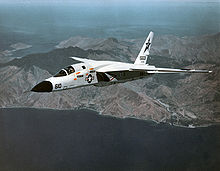 RA-5C Vigilante, BuNo 156608, from Reconnaissance Attack Squadron 7 (RVAH-7) during what may have been its final flight in 1979. This aircraft is now on permanent display at Naval Support Activity Mid-South (formerly NAS Memphis), TN.
RA-5C Vigilante, BuNo 156608, from Reconnaissance Attack Squadron 7 (RVAH-7) during what may have been its final flight in 1979. This aircraft is now on permanent display at Naval Support Activity Mid-South (formerly NAS Memphis), TN.
The Vigilante did not end the career of the A-3 Skywarriors, which would carry on as electronic warfare platforms and tankers, designated as EA-3B and KA-3B, into the 1980s and early 1990s.
Fighters replaced the RA-5C in the carrier-based reconnaissance role. The RF-8G version of the F-8 Crusader, modified with internal cameras, had already been serving in two light photographic squadrons (VFP-62 and VFP-63) since the early 1960s, operating from older aircraft carriers unable to support the Vigilante. The Marine Corps' sole photographic squadron (VMFP-3) would also deploy aboard aircraft carriers during this period with RF-4B Phantom II aircraft. These squadrons superseded the Vigilante's role by providing detachments from the primary squadron to carrier air wings throughout the late 1970s and early to mid-1980s until transfer of the recon mission to the Navy's fighter squadron (VF) community operating the Grumman F-14 Tomcat.
Select models of the F-14 Tomcat would eventually carry the multi-sensor Tactical Air Reconnaissance Pod (TARPS) and the Digital Tactical Air Reconnaissance Pod (D-TARPS). Following up to present day, the weight of fighters such as the F-14 Tomcat and F/A-18E/F Super Hornet have evolved into the same 62,950 lb (28,550 kg) class as the Vigilante. With the retirement of the F-14, the F/A-18E and F/A-18F Super Hornet strike fighters and EA-18G Growler electronic warfare aircraft are planned to cover the strike, reconnaissance, tanker and electronic warfare roles of the F-14 Tomcat, A-6E Intruder, A-7E Corsair II, RF-8G Crusader, RA-5C, KA-6D Intruder, Grumman EA-6B Prowler. S-3B Viking, ES-3A Shadow and EA-3B Skywarrior.
Influence
While the Vigilante served in the attack and reconnaissance roles, its design and planform was a direct descendant of the earlier WS-202 or XF-108 Rapier Mach 3 fighter, designed originally to escort the North American XB-70 Valkyrie bomber. Although both experimental programs were ultimately unsuccessful, the Soviet's MiG-25 "Foxbat" interceptor was greatly influenced by American advances in high speed flight.[11] [N 1] Although there is a superficial resemblance to the F-108/Vigilante configuration, the MiG-25 was an entirely unique design.[12]
Records
On 13 December 1960, Navy Commander Leroy Heath (Pilot) and Lieutenant Larry Monroe (Bombardier/Navigator) established a world altitude record of 91,450.8 feet (27,874.2 m) in an A3J Vigilante carrying a 1,000 kilogram payload, beating the previous record by over four miles (6 km). This new record held for over 13 years.[4]
Variants
- XA3J-1
- Prototypes, two built, one converted to RA-5C.
- A-5A (A3J-1)
- Production nuclear bomber variant; 57 built, 42 converted to RA-5C.
- A-5B (A3J-2)
- Nuclear bomber with greater range. Two prototypes, both converted to RA-5C.
- YA-5C (XA3J-3P)
- Four completed from A-5B order without reconnaissance systems and assigned to pilot familiarization, later converted to RA-5C.
- RA-5C (A3J-3P)
- Reconnaissance version; 91 new-build plus conversions of 43 A-5As and the first six A-5Bs.
- NR-349 Retaliator
- Proposed Improved Manned Interceptor (IMI) for U.S. Air Force with two, later three engines and an armament of six AIM-54 Phoenix missiles.
Operators
Survivors
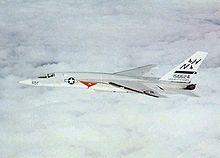 RA-5C BuNo 156624 is preserved at the National Museum of Naval Aviation.
RA-5C BuNo 156624 is preserved at the National Museum of Naval Aviation.
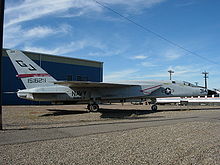 RA-5C BuNo 151629 on display at the Pueblo Weisbrod Aircraft Museum in Pueblo, Colorado in November 2007.
RA-5C BuNo 151629 on display at the Pueblo Weisbrod Aircraft Museum in Pueblo, Colorado in November 2007.
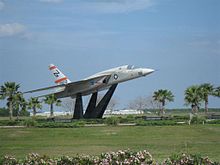 RA-5C Vigilante, BuNo 156632, on display at Orlando Sanford International Airport (formerly NAS Sanford) in late March 2008
RA-5C Vigilante, BuNo 156632, on display at Orlando Sanford International Airport (formerly NAS Sanford) in late March 2008
- Philippines
- A badly graffitied A-5 (BuNo unknown) is on display behind the Tiara Hotel in Subic Bay.
- United States
- A-5A Bureau Number (BuNo) 146697, the oldest Vigilante on display and the only one still in its original A3J/A-5A nuclear attack bomber configuration, is on display at Naval Air Station Patuxent River, Maryland.
- RA-5C BuNo 149289 is on display at the Pima Air & Space Museum in Tucson, Arizona. It was transferred from long-term storage at nearby Davis-Monthan Air Force Base and it carries the markings of RVAH-3.
- RA-5C BuNo 151629 is on display at the Pueblo Weisbrod Aircraft Museum (formerly the Fred E. Weisbrod Museum/International B-24 Museum) in Pueblo, Colorado. It is displayed in the markings of RVAH-3.
- RA-5C BuNo 156608 is on static display at Naval Support Activity Mid-South, formerly Naval Air Station Memphis, Tennessee. It was the last operational RA-5C aircraft and it carries the markings of its last squadron, RVAH-7, during its final deployment aboard the USS Ranger in 1979.
- RA-5C BuNo 156612 is on static display at Naval Air Station Key West, Florida and it stands as a gate marker just inside the main gate. It carries the markings of RVAH-3.
- RA-5C BuNo 156621 was initially on display at the former U.S. Naval Photographic School at NAS Pensacola, Florida. It was then shipped up the East Coast, and it was formerly on display on the USS Intrepid Museum in New York City. In 2005, the RA-5C was acquired by the New York State Aerosciences Museum (ESAM) in Glenville, New York. The aircraft suffered minor damage to its fuselage aft of the wing root while being moved from the aircraft carrier Intrepid to a barge while supported by slings. It is currently (as of 2010) undergoing restoration for display. It carries the markings of the RA-5C Fleet Replacement Squadron (FRS), RVAH-3.
- RA-5C BuNo 156624 in on display at the National Museum of Naval Aviation at NAS Pensacola, Florida. It is displayed in the markings of RVAH-6, per that squadron's final cruise aboard the USS Nimitz in 1978.
- RA-5C BuNo 156632 was placed on display at the Orlando Sanford International Airport (formerly the Naval Air Station Sanford) in Sanford, Florida, in 2004 as a memorial to A-5 aircrewmen and support personnel who served at NAS Sanford. It was transferred from the Naval Air Systems Command (NAVAIR) Weapons Division at Naval Air Weapons Station China Lake, California and is marked as an RVAH-3 aircraft.
- RA-5C BuNo 156638 is on display at Naval Air Station Fallon, Nevada. It was transferred from Naval Air Weapons Station China Lake, California and is marked as an RVAH-12 aircraft.
- RA-5C BuNo 156640 is currently in storage at the Naval Air Weapons Station China Lake, California.
- RA-5C BuNo 156641 is on display at the USS Midway Museum in San Diego. It carries the markings of RVAH-12.
- RA-5C BuNo 156643, the last A-5 built, is on display at the Patuxent River Naval Air Museum, Maryland. It was transferred from NAS Key West, Florida, and it is displayed as a test aircraft operated by the Patuxent River Flight Test Division in the 1970s.
- As of 2004, all RA-5C airframes previously stored with the 309th Aerospace Maintenance and Regeneration Group at Davis-Monthan AFB, Arizona, have either been scrapped or relocated, with some of the planes expended as ground targets in aerial bomb and guided missile tests. A small number of RA-5C airframes in various states of condition are currently stored at Naval Air Weapons Station China Lake, California.
Specifications (A-5A Vigilante)
Data from North American Rockwell A3J (A-5) Vigilante,[13] Combat Aircraft since 1945[14]
General characteristics
- Crew: 2
- Length: 76 ft 6 in (23.32 m)
- Wingspan: 53 ft 0 in (16.16 m)
- Height: 19 ft 4¾ in (5.91 m)
- Wing area: 700 ft² (65.1 m²)
- Empty weight: 32,714 lb (14,870 kg)
- Loaded weight: 47,530 lb (21,605 kg)
- Max takeoff weight: 62,953 lb (28,615 kg)
- Powerplant: 2 × General Electric J79-GE-8 afterburning turbojets
- Dry thrust: 10,900 lbf[15] (48 kN) each
- Thrust with afterburner: 17,000 lbf[15] (76 kN) each
Performance
- Maximum speed: Mach 2.0 (1,149 knots, 1,320 mph, 2,123 km/h) at 40,000 ft (12,200 m)
- Combat radius: 1,121 nmi[dubious ] (1,289 mi, 2,075 km)
- Ferry range: 1,571 nmi (1,807 mi, 2,909 km)
- Service ceiling: 52,100 ft (15,880 m)
- Rate of climb: 8,000 ft/min (40.6 m/s)
- Wing loading: 80.4 lb/ft² (308.3 kg/m²)
- Thrust/weight: 0.72
Armament
- Bombs:
- 1× Mark 27 nuclear bomb, B28 or B43 freefall nuclear bomb in internal weapons bay
- 2× B43, Mark 83, or Mark 84 bombs on two external hardpoints
Avionics
Systems carried by A-5 or RA-5C[16][17]- AN/ASB-12 Bombing & Navigation Radar (A-5, RA-5C)
- Westinghouse AN/APD-7 SLAR (RA-5C)
- Sanders AN/ALQ-100 E/F/G/H-Band Radar Jammer (RA-5C)
- Sanders AN/ALQ-41 X-Band Radar Jammer (A-5, RA-5C)
- AIL AN/ALQ-61 Radio/Radar/IR ECM Receiver (RA-5C)
- Litton ALR-45 "COMPASS TIE" 2-18 GHz Radar Warning Receiver (RA-5C)
- Magnavox AN/APR-27 SAM Radar Warning Receiver (RA-5C)
- Itek AN/APR-25 S/X/C-Band Radar Detection and Homing Set (RA-5C)
- Motorola AN/APR-18 Electronic Reconnaissance System (A-5, RA-5C)
- AN/AAS-21 IR Reconnaissance Camera (RA-5C)
See also
- Related development
- Aircraft of comparable role, configuration and era
- Related lists
References
- Notes
- Citations
- ^ a b Wagner 1982, p. 361.
- ^ a b Dean 2001, p. 23.
- ^ Siuru 1981, p. 15.
- ^ a b c d Siuru 1981, p. 16.
- ^ Ellis 2008, p. 64.
- ^ Thomason 2009, p.112.
- ^ Goebel, Greg. "The North American A-5/RA-5 Vigilante." vectorsite.net, 5 April 2007. Retrieved: 2 March 2008.
- ^ Goodspeed 2000, p. 51.
- ^ Ellis 2008, p. 63.
- ^ "The United States Naval Aviation 1910–1995, pp. 324–325". history.navy.mil. Retrieved: 10 August 2010.
- ^ a b Butowski and Miller 1991, p. 107.
- ^ Buttler 2007, p. 79.
- ^ Goodspeed 2000, p. 77.
- ^ Wilson 2000, p. 114.
- ^ a b Taylor 1965, p. 274.
- ^ Parsch, Andreas. "Designations Of U.S. Military Electronic And Communications Equipment". http://www.designation-systems.net/usmilav/electronics.html#_JETDS_AN_Listings. Retrieved 5 June 2011.
- ^ Eden, Paul (2009). Modern Military Aircraft Anatomy. London: Amber Books Ltd. pp. 220, 221. ISBN 978-1-905704-77-4.
- Bibliography
- Buttler, Tony. American Secret Projects: Fighters & Interceptors 1945-1978. Hinckley, UK: Midland Publishing, 2007. ISBN 978-1857802641.
- Butowski, Piotr with Jay Miller. OKB MiG: A History of the Design Bureau and Its Aircraft. Leicester, UK: Midland Counties Publications, 1991. ISBN 0455-847256,
- Dean, Jack. "Sleek Snooper." Airpower, Volume 31, No. 2, March 2001.
- Donald, David and Jon Lake, eds. Encyclopedia of World Military Aircraft. London: AIRtime Publishing, 1996. ISBN 1-880588-24-2.
- Ellis, Ken, ed. "North American A-5 Vigilante" (In Focus). Flypast, August 2008.
- Goodspeed, M. Hill. "North American Rockwell A3J (A-5) Vigilante". Wings of Fame, Volume 19, pp. 38–103. London: Aerospace Publishing, 2000. ISBN 1-86184-049-7.
- Gunston, Bill. Bombers of the West. London: Ian Allan Ltd., 1973, pp. 227–235. ISBN 0-7110-0456-0.
- Powell, Robert. RA-5C Vigilante Units in Combat. London: Osprey Publishing Ltd., 2004. ISBN 1-84176-749-2.
- Siuru, William. "Vigilante: Farewell to the Fleet's Last Strategic Bomber!" Airpower, Volume 11, No. 1, January 1981.
- Taylor, John W. R. Jane's All The World's Aircraft 1965-66. London: Sampson Low, Marston, 1965.
- Taylor, John W.R. "North American A-5 Vigilante." Combat Aircraft of the World from 1909 to the Present. New York: G.P. Putnam's Sons, 1969. ISBN 0-425-03633-2.
- Thomason, Tommy H. "Strike from the Sea". North Branch, MN: Specialty Press, 2009. ISBN 978-1-58077-132-1.
- Wagner, Ray. American Combat Planes. Garden City, NY: Doubleday & Company, third edition 1982. ISBN 0-385-13120-8.
- Wilson, Stewart. Combat Aircraft since 1945. Fyshwick, Australia: Aerospace Publications, 2000. ISBN 1-875671-50-1
External links
- Department of the Navy - Naval Historical Center
- National Museum of Naval Aviation
- A-5/RA-5 Vigilante at vectorsite.net
- A-5 Vigilante at Subic Bay youtube link
United States tri-service attack aircraft designations post–1962 Main sequence Non-sequential designations V/STOL sequence See also: EA-18GUSN/USMC attack aircraft designations 1946-1962 Douglas Grumman McDonnell Douglas North American Martin Vought Lists relating to aviation General Aircraft (manufacturers) · Aircraft engines (manufacturers) · Airlines (defunct) · Airports · Civil authorities · Museums · Registration prefixes · Rotorcraft (manufacturers) · TimelineMilitary Accidents/incidents Records Categories:- Carrier-based aircraft
- United States attack aircraft 1950–1959
- United States military reconnaissance aircraft 1950–1959
- Military aircraft of the Vietnam War
- North American Aviation aircraft
- Twinjets
Wikimedia Foundation. 2010.




